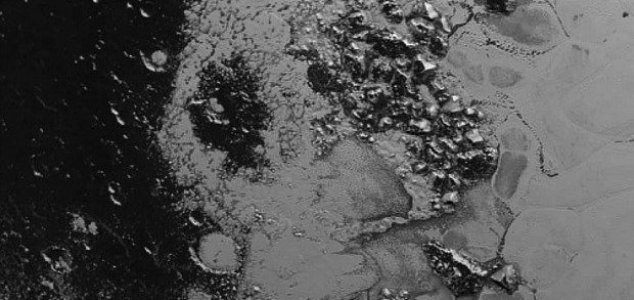
The mountains lie in an area between two vastly different regions.
It has only been a few days since the first high resolution photographs of Pluto were returned by the spacecraft and already much has been revealed about what lies on this distant, icy world.
Earlier images of mountains comparable in height to the Rockies here on Earth have been joined by further pictures showing a separate chain of peaks similar in size to the Appalachian Mountains.
These remarkable geological features span the edge of Pluto’s distinctive ‘heart’ which has since turned out to be broken up in to several different regions with varying textures and reflectivity.
Scientists are still working to determine the processes responsible for the stark transition between the dark crater-marked region on one side and the smooth frozen plains on the other.
Pluto (minor-planet designation: 134340 Pluto) is a dwarf planet in the Kuiper belt, a ring of bodies beyond Neptune. It was the first Kuiper belt object to be discovered. It is the largest and second-most-massive known dwarf planet in the Solar System and the ninth-largest and tenth-most-massive known object directly orbiting the Sun. It is the largest known trans-Neptunian object by volume but is less massive than Eris, a dwarf planet in the scattered disc. Like other Kuiper belt objects, Pluto is primarily made of ice and rock[14] and is relatively small—about one-sixth the mass of the Moon and one-third its volume. It has a moderately eccentric and inclined orbit during which it ranges from 30 to 49 astronomical units or AU (4.4–7.3 billion km) from the Sun. This means that Pluto periodically comes closer to the Sun than Neptune, but a stable orbital resonance with Neptune prevents them from colliding. In 2014, Pluto was 32.6 AU from the Sun. L
“There is a pronounced difference in texture between the younger, frozen plains to the east and the dark, heavily-cratered terrain to the west,” said New Horizons geophysicist Jeff Moore.
“There’s a complex interaction going on between the bright and the dark materials that we’re still
Originally posted 2015-09-03 16:09:12. Republished by Blog Post Promoter











